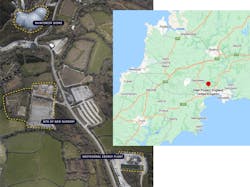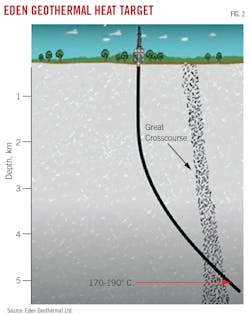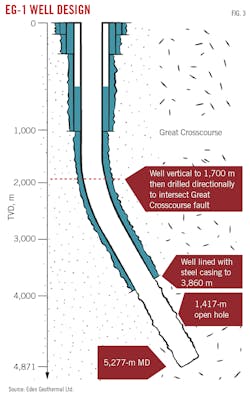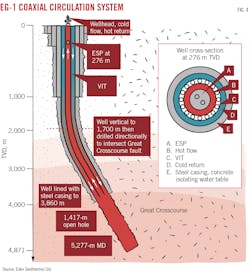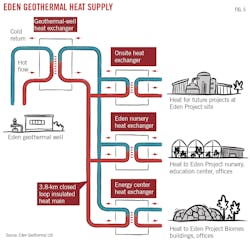Eden Geothermal Ltd. (EGL) is UK’s first deep geothermal project to come online in 37 years. A 5 km deep geothermal system heats Eden Project Biomes—the world’s largest indoor rainforest and Growing Point nursery—both built on a former china clay pit in Cornwall, UK (Fig. 1). The Growing Point nursery is between the geothermal site and Biomes and eliminates a pre-existing off-site nursery, reducing food-miles and dependence on fossil fuels.
Eden Project Phase 1 delivers heat and demonstrates a downhole coaxial circulation system. Phase 2 will include a second well to supply heating and electrical generation. Deep granite drilling for Phase 1 concluded in 2021, and EGL completed the heat mainline and plant in 2023. The project started generating heat June 19, 2023.
EGL is a three-way partnership between Eden Project Ltd., EGS Energy Ltd., a geothermal development and consultancy group, and BESTEC (UK) Ltd., affiliated with BESTEC GMBH, a specialist geothermal developer and drilling advisor.
Eden heat reservoir
The well, the longest geothermal well in the UK, contains a deep single-well coaxial heat exchanger. Water is injected down the annulus, heated at the reservoir, and returns inside vacuum-insulated tubing (VIT). The water passes through a surface heat exchanger where it is cooled and subsequently reinjected into the well. A 3.8-km insulated main line delivers heat at about 85° C. to Project Biomes and the nursery.
Drilling
Well EG-1 spud in May 2021 and was completed that October. The deviated well was drilled to 4,871-m TVD and 5,277-m MD using conventional rotary drilling and water-based mud with mud cooled at surface during the later stages. Steel casing lines the upper three sections, but the bottom section is an open hole (Fig. 3).
The 34-36 in. conductor sections were drilled as part of site completion before the main rig arrived. They were drilled through loose weathered ground near the surface until reaching competent bedrock at 32 m. Wide-diameter steel conductor-pipe was cemented into place to seal off the top hole from loose, soft ground and to form a stable start collar for drilling.
The rig drilled a 26-in. section between 32 m and 240 m, requiring two 26-in. drill bits, each weighing 630 kg, to get to depth. The section was lined with 20-in. steel casing cemented in place using a 1.1 kg/l. lightweight cement slurry containing silica and hollow glass spheres. The 17 ½-in. section was drilled using eight 17 ½-in. bits. The section drilled to 1,510 m and was cased and cemented with 13 3/8-in. diameter casing.
The 12 ¼-in. section represents the longest section of the well. Kick-off point was 1,706 m, deviating east away from vertical and towards the target zone in the Great Crosscourse fault. The 12 ¼-in. section was cased just before 4,000 m MD. The open hole section was drilled out of this casing using an 8 ½-in drill bit for the last 1,417 m of the well. Drilling took 162 days.
Testing
Heat and permeability comprise the two key elements for a successful deep geothermal energy system. Well tests quantified these parameters and provided information on petrography, hydrogeology, and geomechanical conditions of the rock at 4,500 m. Tests were designed to:
- Characterize the permeability-impedance of the target zone.
- Evaluate the spatial extent of fracture distribution and orientation in the target zone.
- Characterize flowing zones and evaluate the far-field flow contribution.
- Generate models from the data to understand the regional geothermal resource.
Well tests were conducted at production and reinjection rates. A 3,200-cu m lagoon served as a water storage site during the tests. The lagoon also contained and treated water released from the well during maintenance or normal running.
Well tests started in late January 2022 and lasted several weeks. Further tests were carried out in August, September, and November of that year. Permeability was derived from both water injectivity and production tests.
Injection tests were carried out first using cold water injected from the surface at low pressure and low flow rates. Over time, gradual and incremental flow rate increases were conducted to assess the well’s ability to accept fluid. Pressures and flow rates were continuously monitored. Microseismic monitors in the vicinity of the well site provided real-time data during drilling and testing. These data outlined the spatial extent of the geothermal heat source and aided control of injection and production during well testing to minimize seismic impact.
Production tests assessed the well’s ability to produce fluid. After the injection tests, a compressor injected air 600-700 m down open-ended tubing placed in the top of the well, lightening the column and inducing drawdown within the borehole. Hot water subsequently flowed from the formation surrounding the open-hole section up the well. Produced water was directed to a unit to separate air and discharge water into the lagoon. Test duration was usually short (12-24 hr) and could produce steam at surface. During the test, downhole pressures and flow rates were continuously monitored to provide well productivity data.
Seismicity
A seismic monitoring network was installed before drilling to detect low-level seismicity associated with well testing and to provide real-time data to manage and control operations.
The system recorded more than 300 microseismic events during initial injection and production tests from January through March 2022, and data from these events outlined water flow direction in relation to the well. Most recorded events were below Magnitude (M) = 0 but two, an M = 1.5 and an M = 1.7 (1.56 mm/sec peak ground velocity) were felt and heard at surface. The latter event paused the test program. Testing resumed a week later and finished by the end of March without further surface-felt seismicity. A production test was performed in August followed by more injection testing which was completed early in September. These tests also generated hundreds of microseismic events, but none were felt or heard at surface. The last round of injection tests before installation of the coaxial heat system was carried out in 5-10 days during November 2022.
Heating system
The heat main line consists of two 6-in. steel pipes (flow and return) with a thick layer of insulation increasing total diameter to 11 in. The lines link the geothermal well with heat loads at Growing Point and the Eden Energy Centre using heat exchangers (Fig. 5). Cooled water returns to the geothermal site to be reheated. The heat main is below ground except for a short stretch behind Eden Project’s main office building.
About the Author
Alex Procyk
Upstream Editor
Alex Procyk is Upstream Editor at Oil & Gas Journal. He has also served as a principal technical professional at Halliburton and as a completion engineer at ConocoPhillips. He holds a BS in chemistry (1987) from Kent State University and a PhD in chemistry (1992) from Carnegie Mellon University. He is a member of the Society of Petroleum Engineers (SPE).
